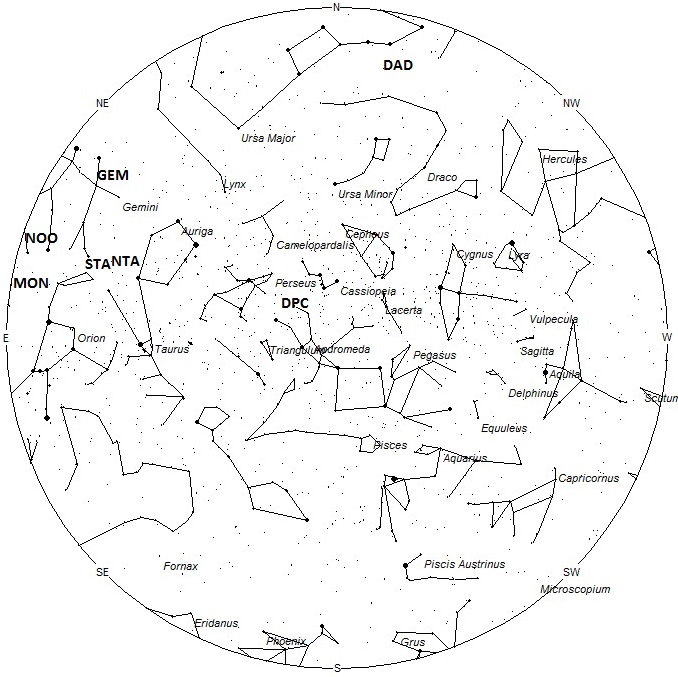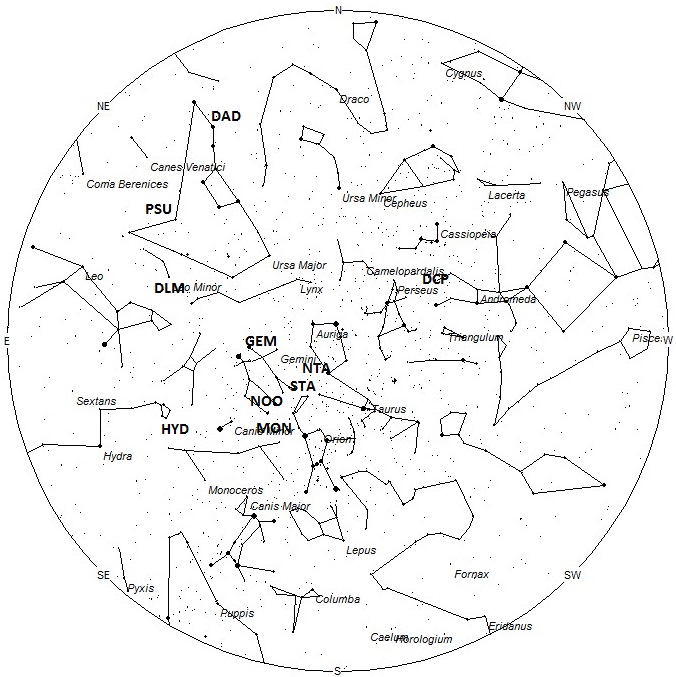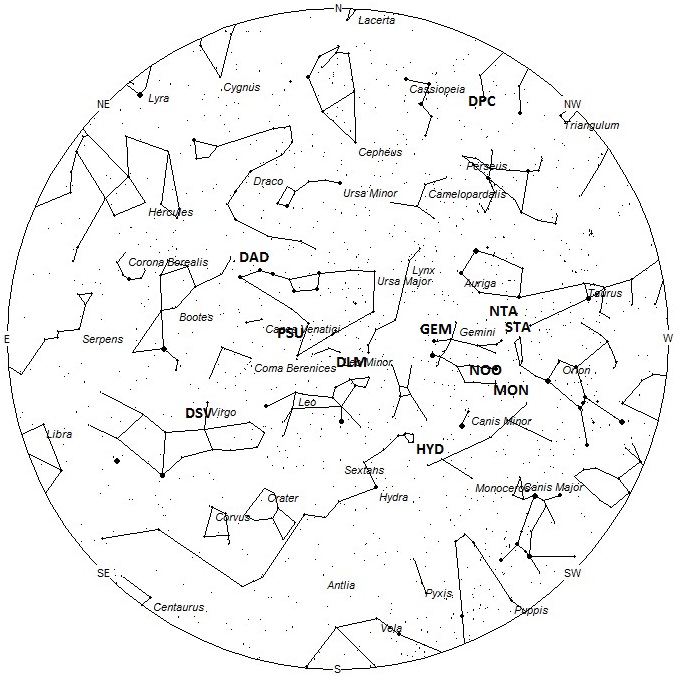
Uploaded on the AMS Website by S. Vetter – © S.Vetter
During this period the moon will wax from a slender crescent phase to nearly half illuminated. This will be a great time to view meteor activity as the moon will have set by the time the more active morning hours arrive. The moon will be present during the evening hours but successful meteor observing is still possible during this time by simply keeping the moon out of your field of view. The estimated total hourly meteor rates for evening observers this week is near 4 as seen from mid-northern latitudes (45N) and 3 as seen from tropical southern locations (25S). For morning observers the estimated total hourly rates should be near 32 as seen from mid-northern latitudes and 24 from the southern tropics. The actual rates will also depend on factors such as personal light and motion perception, local weather conditions, alertness and experience in watching meteor activity. Note that the hourly rates listed below are estimates as viewed from dark sky sites away from urban light sources. Observers viewing from urban areas will see less activity as only the brighter meteors will be visible from such locations.
The radiant (the area of the sky where meteors appear to shoot from) positions and rates listed below are exact for Saturday night/Sunday morning December 8/9. These positions do not change greatly day to day so the listed coordinates may be used during this entire period. Most star atlases (available at science stores and planetariums) will provide maps with grid lines of the celestial coordinates so that you may find out exactly where these positions are located in the sky. A planisphere or computer planetarium program is also useful in showing the sky at any time of night on any date of the year. Activity from each radiant is best seen when it is positioned highest in the sky, either due north or south along the meridian, depending on your latitude. It must be remembered that meteor activity is rarely seen at the radiant position. Rather they shoot outwards from the radiant so it is best to center your field of view so that the radiant lies near the edge and not the center. Viewing there will allow you to easily trace the path of each meteor back to the radiant (if it is a shower member) or in another direction if it is a sporadic. Meteor activity is not seen from radiants that are located far below the horizon. The positions below are listed in a west to east manner in order of right ascension (celestial longitude). The positions listed first are located further west therefore are accessible earlier in the night while those listed further down the list rise later in the night.
These sources of meteoric activity are expected to be active this week.
The December phi Cassiopeiids (DPC) are the classical return of the Andromedids and the radiant that was active prior to the breakup of comet 3D/Biela in the 1840’s. This source is active from November 28 through December 10th. Maximum activity was expected to occur on December 6th when the Earth passes closest to particles released by 3D/Biela in 1649. The expected radiant is located at 01:36 (024) +50 on the night of maximum activity. This area of the sky is located just northwest of the 4th magnitude star known as Nembus (51 Andromedae). This position is also very close to the border with Cassiopeia and in some years the radiant lies in Cassiopeia, hence the name of phi Cassiopeiids. These meteors are best seen near 2100 (9pm) Local Standard Time (LST). Meteors from the December Phi Cassiopeiids strike the atmosphere at 17km/sec., which would produce meteors of very slow velocity. Expected rates would be low away from maximum. There have been no reports of visual activity so far. Rates could be strong but the meteors may be faint and difficult to see. Therefore those viewing from urban areas may see nothing at all. At only 17 km/sec. the December phi Cassiopeiids would also produce extremely slow meteors.
The Northern Taurids (NTA) are active from a large radiant located at 05:48 (087) +30. This area of the sky is located in southern Auriga, 4 degrees northeast of the 2nd magnitude star known as El Nath (beta Tauri). This position is close to the Southern Taurids so great care must be taken in separating these meteors. You must have the two radiants near the center of your field of view to properly differentiate these sources. Current rates would be 2 per hour as seen from the northern hemisphere and 1 per hour as seen from south of the equator. These meteors may be seen all night long but the radiant is best placed near midnight local standard time (LST) when it lies on the meridian and is located highest in the sky. With an entry velocity of 28 km/sec., the average Northern Taurid meteor would be of slow velocity.
The Southern Taurids (STA) are active from a large radiant centered near 05:58 (089) +24. This position lies in western Gemini, close to the position occupied by the 4th magnitude star known as 1 Geminorum. These meteors may be seen all night long but the radiant is best placed near midnight LST when it lies on the meridian and is located highest in the sky. Current rates would be 1 per hour as seen from the northern hemisphere and less than 1 per hour as seen from south of the equator. With an entry velocity of 27 km/sec., the average Southern Taurid meteor would be of slow velocity.
The Monocerotids (MON) are active from November 28th through December 27th with the peak activity occurring on December 13th. The radiant is currently located at 06:36 (099) +08. This position lies in northern Monoceros, 7 degrees east of the 1st magnitude orange star known as Betelgeuse (Alpha Orionis). This position is only 7 degrees south of the radiant of the November Orionids so care must be take to distinguish between the two. Current rates should be near 1 per hour no matter your location. Rates at maximum may reach 2 per hour. The Monocerotids are best seen near 0100 LST when the radiant lies highest above the horizon. At 41 km/sec. the Monocerotids produce mostly meteors of medium velocity.
The November Orionids (NOO) are active from a radiant located at 06:46 (102) +15. This area of the sky lies in southern Gemini, 2 degrees east of the 2nd magnitude star known as Alhena (gamma Geminorum). This area of the sky is best placed in the sky near 0100 LST, when it lies highest above the horizon. This stream is active from November 7 through December 17, with maximum activity occurring on November 29. Rates should be near 2 per hour no matter your location. With an entry velocity of 43 km/sec., most activity from this radiant would be of medium speed.
The Geminids (GEM) are active from December 1-22, with peak activity occurring on December 14th. This weekend the radiant is located near 07:14 (109) +33. This position lies in northern Gemini, 3 degrees northwest of the 2nd magnitude star known as Castor (alpha Geminorum). Rates this weekend should be near 10 per hour as sen from the northern hemisphere and 5-7 in the southern hemisphere . Hourly rates will increase dramatically as the week progresses. At 34 km/sec. the Geminids produce mostly meteors of medium velocity.
The Puppid-Velids (PUP) are a vast complex of weak radiants located in the constellations of Puppis and Vela. Visual plots and photographic studies have revealed many radiants in this area during November and December. The combined strength of these radiants can produce a ZHR of 10. Actual hourly rates will be much less unless you happen to be observing from the deep Southern Hemisphere. Activity from this source begins around December 1st. The center of this activity is currently located at 08:16 (124) -45. This position lies on the Puppis/Vela border, 2 degrees north of the 2nd magnitude star known as gamma Velorum. Peak rates occurred near December 7. These meteors are best seen near 0300 LST when the radiant lies highest above the horizon in a dark sky. Observers located in the Southern Hemisphere have an advantage viewing this shower as the radiant will rise higher into their sky allowing more activity to be seen. Since the radiant lies low in the south for most northern hemisphere observers, meteors seen from north of the equator tend to be long in length and long-lasting. At 40 km/sec. the Puppid-Velids produce meteors of average velocity.
The Sigma Hydrids (HYD) are active from November 24 through December 21, with maximum activity occurring on December 6. The radiant is currently located at 08:24 (126) +02 , which places it in extreme western Hydra, 3 degrees southwest of the 4th magnitude star known as sigma Hydrae. These meteors are best seen near 0400 LST when the radiant lies highest above the horizon. Hourly rates are expected to be near 3 per hour no matter your location. With an entry velocity of 62 km/sec., most activity from this radiant would be of swift speed.
The December Leonis Minorids (DLM) are a shower of long duration active from December 6th through January 18th. Maximum occurs near December 21st when rates may reach 3 an hour. During this period I would expect an hourly rates near 1 from a radiant located at 09:57 (149) +35. This position lies in western Leo Minor, 2 degrees southwest of the faint star known as 21 Leo Minoris. These meteors are best seen near 0400 LST when the radiant lies highest above the horizon. At 63 km/sec. the December Leonis Minorids produce mostly swift meteors.
The last of the Psi Ursa Majorids (PSU) are expected this weekend. This shower is active from December 2-10 with maximum activity occurring on December 5th. The radiant is currently located at 11:31 (173) +41. This position lies in central Ursa Major, 4 degrees southeast of the third magnitude star known as Psi Ursae Majoris. This area of the sky is best placed during the last hour before dawn, when it lies highest above the horizon in a dark sky. Current rates would most likely be less than one per hour and may reach 1 per hour at maximum. Observers south of the equator would see rates less than 1 per hour due to the lower radiant elevation. At 62km/sec., the average Psi Ursa Majorid meteor would be swift.
The December Sigma Virginids (DSV) was discovered by John Greaves using the data of SonotaCo. IMO video cameras confirmed that this source is active during the month of December. Peak rates occur near December 14th. The current radiant location is at 13:05 (196) +08 which places it in northern Virgo, 3 degrees south of the 3rd magnitude star known as Vindemiatrix (epsilon Virginis). Current hourly rates should be near 1 shower member no matter you location. These meteors are best seen during the last dark hour before dawn, when the radiant lies highest above the horizon in a dark sky. At 68 km/sec. the December Sigma Virginids would produce mostly swift meteors.
The December Alpha Draconids (DAD) were discovered by the Japanese observers using data from SonotaCo and is active from November 30-December 15. They are predicted to peak on December 8th from a radiant located at 13:34 (204) +58. This position actually lies in northeastern Ursa Major, 3 degrees northeast of the second magnitude star known as Mizar (zeta Ursae Majoris). These meteors are best seen during the last dark hour before dawn, when the radiant lies highest above the horizon in a dark sky. This shower is not well seen from the southern hemisphere. Current rates would most likely be near 1 per hour as seen from the northern hemisphere. Observers south of the equator would see rates less than 1 per hour due to the lower radiant elevation. Some meteor experts feel these meteors are part of the Quadrantid shower, which peaks in early January.
As seen from the mid-northern hemisphere (45N) one would expect to see approximately 11 sporadic meteors per hour during the last hour before dawn as seen from rural observing sites. Evening rates would be near 3 per hour. As seen from the tropical southern latitudes (25S), morning rates would be near 9 per hour as seen from rural observing sites and 2 per hour during the evening hours. Locations between these two extremes would see activity between the listed figures.
The list below offers the information from above in tabular form. Rates and positions are exact for Saturday night/Sunday morning except where noted in the shower descriptions.
| SHOWER | DATE OF MAXIMUM ACTIVITY | CELESTIAL POSITION | ENTRY VELOCITY | CULMINATION | HOURLY RATE | CLASS |
| RA (RA in Deg.) DEC | Km/Sec | Local Standard Time | North-South | |||
| Dec. Phi Cassiopeiids (DPC) | Dec 06 | 01:36 (024) +50 | 17 | 21:00 | <1 – <1 | III |
| Northern Taurids (NTA) | Nov 11 | 05:48 (087) +30 | 28 | 00:00 | 2 – 1 | II |
| Southern Taurids (STA) | Oct 30-Nov 02 | 05:58 (089) +24 | 27 | 00:00 | 1 – <1 | II |
| Monocerotids (MON) | Dec 13 | 06:36 (099) +08 | 41 | 01:00 | 1 – 1 | II |
| November Orionids (NOO) | Nov 29 | 06:46 (102) +15 | 43 | 01:00 | 2 – 2 | II |
| Geminids (GEM) | Dec 14 | 07:14 (109) +33 | 34 | 02:00 | 10 – 6 | I |
| Puppid/Velids (PUP) | Dec 07 | 08:20 (125) -45 | 40 | 03:00 | <1 – 1 | II |
| sigma Hydrids (HYD) | Dec 06 & Dec 18 | 08:28 (127) +02 | 61 | 03:00 | 3 – 3 | II |
| December Leonis Minorids (DLM) | Dec 21 | 09:57 (149) +35 | 63 | 04:00 | 1 – <1 | II |
| psi Ursa Majorids (PSU) | Dec 05 | 11:31 (173) +41 | 62 | 05:00 | <1 – <1 | IV |
| December sigma Virginids (DSV) | Dec 13 | 13:05 (196) +08 | 66 | 07:00 | 1 – 1 | IV |
| December alpha Draconids (DAD) | Dec 04 | 13:34 (204) +58 | 44 | 08:00 | <1 – <1 | IV |
 American Meteor Society
American Meteor Society



I witnessed a meteor fall in New Berlin, Texas this evening. My family was returning from San Antonio from Christmas shopping & saw the meteor fall right at 8pm. It lasted a good 30 secs plus from first light till it’s light grew & turned green before it broke apart & disappeared. I did not hear any sound that accompanied the meteor.
I saw a blue green meteor last night 5 pm flying north to south over Flemington NJ it was awesome with a tail of white sparks!
For the NON informed about the details of a night sky. When looking into the sky (at night) what direction? N?S?E?W? degrees from north would help. Up from the horizon 10, 20, 30, 40. Wonderful site I guess for the intellectually informed but us common people would like to see something also. Right now after searching lots of sites all I get is names of constellations, I have enough trouble finding the dipper.
All I want is to see a real meteor shower before I kick the bucket. It’s on my list, the last I went to observe in 5 hours I counted 5 on a very clear night. Was I looking in the right direction, around the right time, NOT a clue I was alone, no one wanted to go alone because of similar results from web site info.
Does anyone have details for the uninformed to go into a dark location look up and see something?
Walt and All,
If your sky is clear tonight go outside after the moon has set, which will be between 10-11pm local time. Get comfortable in a chair and look toward the east about half way up in the sky. I guarantee you will see some meteors. How many you will see depends on how dark you sky is. If you see enough of these you will begin to notice that they all appear to come from one area of the sky. These meteors will appear in all parts of the sky but will still trace back to the same source which we call the radiant. You will see the most activity near 2:00am (time zone does not matter) when the radiant lies overhead.
Good Luck!
Just seen a green fireball similar to that of a flare with a trail of ember balls falling off of it
Ware ma
I witnessed twin green fireballs from Grove, Oklahoma in the Northwestern sky at around 10:30 p.m. Dec 14 2018
the downward trajectory aprox 20 degrees from right to left of perpendicular to the horizon.
the elevation relative to horizon appeared to be about 30 degrees.
The two fireballs seemd to have originated from a single point in that the path of the burns intersected at a previous dark point and they were spreading apart during the burn phase.
It was very bright and seemed like a firework rocket only a mile away. But based on the known burn altitudes of such things it must have been hundreds of miles away. That seems to imply it was quite a large mass.